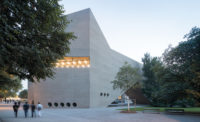An expansion designed by :mlzd Architects, based in Biel, Switzerland, for the Historisches Museum Bern creates a multileveled dialogue between old and new architecture. Designed by the Swiss architect André Lambert in 1894, the original structure is near the Kirchenfeld Bridge, which crosses the Aare River and connects this area’s cluster of museums to the historic section of Bern. Lambert designed the history museum in a Revivalist style to recall architecture (especially castles) of the 15th and 16th centuries. Over time, the museum — which houses collections devoted to prehistoric material, folk art, ethnographic objects, and various kinds of decorative and applied art — found it urgently needed to expand. Fortunately, a donation of 2 million Swiss francs (approximately $2,020,000) from the Abegg Foundation enabled the museum to organize an international architectural competition in 2000 for the design of an extension.
Additional Content:
Jump to credits & specifications
Program
The expansion called for an additional floor area (79,653 square feet) that would include a 22,604-square-foot exhibition hall and accommodations for the city archive, offices, and a library.
The winning scheme, then called Kubus/Titan (now just Titan), was conceived by the 20-member architectural firm :mlzd, founded in 1997 and known in Switzerland for its Modern houses, office buildings, schools, and museums. Principals include Claude Marbach, Roman Lehmann, Pat Tanner, Daniele Di Giacinto, and Lars Mischkulnig.
Solution
The architects designed the new annex to include two main elements: The first is an exhibition hall buried at the southeast corner of the older museum, with 21,528 square feet of storage accommodated on two levels underneath. The other element is a monolithic six-story structure that demarcates the southern edge of the site and contains ancillary services. A cascading interior stair runs along the inclined south elevation to connect the floors.
By burying the exhibition hall, :mlzd killed two birds with one stone. On one hand, the architects integrated the large volume needed for the museum into a limited space without violating the scale of the setting. On the other, they met the demands of creating an exhibition space that could function as a black box free of natural light.
Moreover, the roof of the submerged exhibition hall provides a public plaza that spans both the old museum and the new monolithic structure.
The massive concrete walls of the new wing give the south, east, and west elevations a fortified appearance in keeping with the older museum. On the north elevation, a flat, fully glazed curtain wall helps frame the public plaza and spectacularly reflect its surroundings.
The structural engineers had to underpin the old building and secure the excavated pit for the new exhibition hall by tying back reinforced concrete walls to anchors in the ground. In addition, the architects and engineers spanned the hall with a prestressed, ribbed concrete ceiling, allowing it to be column-free for flexibility of installations.
For the office block, the team developed a complex load-bearing structure consisting of one-story cast-in-place concrete columns on the north side and a monolithic structure of 14-inch-thick concrete walls on the other three sides.
Commentary
In splitting the structure into exhibition hall and office building, :mlzd reinterpreted the typologies of the podium and the tower. Evoking the image of a rock, the polygonal block acts as a visible landmark while relating visually to the mountains (Eiger, Mönch, Jungfrau) in the background and the Lambert-designed museum in front. By adding greenish-white cement pigment to the concrete, the architects harmonized the color of the facades with the sandstone masonry of the existing museum building.
In creating six facades on the south, east, and west elevations — three of which are inclined by 96.66, 82.69, and 80.11 degrees — :mlzd alluded to the articulation of the older museum’s facades. The texture of the walls of the new structure echoes the roughly finished stones that accentuate the corners and arched windows of the original building.
By photographing them and then enlarging them as pixels, the architects designed recesses and perforations for the concrete walls that optically soften the surfaces. Some of these perforations turn out to be window openings.
The fully glazed curtain wall wrapping the north elevation seems to reveal the cut surface of the massive rock as if it were a gemstone. On sunny days, it reflects the museum facade opposite, and from a point of view parallel to the glass panels, it even completes the older building’s design by turning it into a symmetrical composition.
In this manner, the glossy facade acts as a referential backdrop that sometimes turns out to be a literal one, for the plaza is planned to be used as a stage for medieval performances. The architects have succeeded in creating an extension that both responds to the late 19th-century museum and competes with it — simply because it does not cozy up to the original.
Total construction cost: $26.3 million
Gross square footage: 79,653 sq.ft.
Completion date: September 2009
PeopleOwner Historisches Museum Bern BHM Architect: :mlzd Personnel in architect's firm who should receive special credit: Interior designer: :mlzd Engineer(s): Tschopp Ingenieure GmbH IBMM Ingenieurbüro Brücker Ingenieure AG Consultant(s) Landscape: Photographer(s): Alexander Gempeler Christoph Schütz CAD system, project management, or other software used: VectorWorks |
ProductsStructural System Metal/glass curtain wall: Concrete work: A. Bill AG Roofing Elastomeric: Windows Metal frame: Interior finishes Suspension grid: Furnishings Other furniture: Lighting Downlights: Conveyance Elevators/Escalators: |












Post a comment to this article
Report Abusive Comment